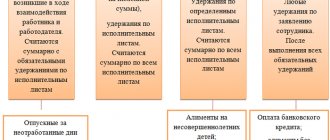Retention: conditions of application and methods of protecting the debtor
Conditions for applying withholding
Retention is one of the ways to ensure the fulfillment of an obligation <*>. To apply retention of an item, the creditor must meet a number of conditions.
1. There are legal obligations arising from the transaction between the creditor and the debtor and the debtor does not fulfill the obligation <*>. These may be situations where:
1) the debtor did not pay for the retained item on time or did not compensate for the costs and other losses associated with it (for example, the contractor carried out repairs on the item, and the customer did not pay for it on time) <*>;
2) the creditor has claims against the debtor for any other obligations, including those not related to payment for the thing or compensation for costs and other losses, if the parties act as entrepreneurs (for example, the tenant at the end of the lease did not remove his things and did not pay rent) <*>.
Withholding as a measure to ensure the fulfillment of an obligation cannot be applied to legal relations related to non-payment of penalties and interest for the use of other people's funds. Since penalties and interest are measures of civil liability, they are not considered as obligations in respect of which interim measures can be applied.
2. Item held:
1) is subject to transfer to the debtor or a person specified by the debtor;
2) came into the possession of the creditor legally. The possibility of its retention cannot be a consequence of the seizure of the debtor's property against his will (for example, the lessor can retain the tenant's property for failure to pay rent if he left the property in the premises after the end of the lease);
3) belongs to the debtor by right of ownership or by other legal right and is alien to the creditor.
As part of one of the legal disputes, the court indicated: the defendants holding the vehicles did not have rights to them. The vehicles belonged to the plaintiff, and there was no contractual relationship between the plaintiff and the defendants. Therefore, the retention of vehicles due to failure to fulfill obligations by third parties was unlawful and, accordingly, illegal <*>.
If the creditor does not transfer his thing, this means that he does not retain it, but suspends the fulfillment of the obligation <*>;
4) has a value that does not significantly exceed the amount of the debt.
The legislation does not establish requirements for the ratio of the amount of debt to the value of the item. However, the debtor has the right to challenge the withholding if the thing is significantly more expensive than the debt. In this case, the retention can be considered unfair behavior <*>.
3. The agreement does not establish a prohibition on retention.
The right to retain a thing exists by force of law, regardless of whether the contract provides for such a right. However, the parties to the contract may limit or exclude the use of withholding <*>.
In some cases, withholding is not allowed even if there are grounds (for example, an item is subject to inclusion in the bankruptcy estate of a bankrupt debtor).
Possible cases of retention of an item
Subject to all the above conditions, the creditor has the right to withhold:
- things transferred by the debtor for storage, if the debtor has not paid for storage services and other related costs;
- things that the creditor, as a commission agent, must transfer to the principal or other person when the principal violates obligations under the contract <*>;
- equipment, leftover materials and other property of the customer that ends up in the hands of the creditor as a contractor in the event that he fails to meet the deadlines for payment for work performed <*>;
- property left by the former tenant after termination of the lease agreement, if there is a rent arrears to the creditor-lessor;
- goods transferred to the carrier for transportation if the sender has delayed payment for transportation <*>.
As stated in paragraph 43 of the resolution of the Plenum of the Supreme Economic Council No. 9, the carrier, based on paragraph 4 of Art. 744, paragraph 1, art. 340 Civil Code, clause 101 of the Rules for road transport of goods:
- has the right to retain the transported cargo to secure the carriage charge due to it and other payments for transportation (if there are overdue receivables to the carrier for the transport work performed). The contract cannot limit such a right;
- does not have the right to retain the transported cargo to secure the carriage charge due to it and other payments for transportation until the payment is due;
- does not have the right to retain the transported cargo to secure the carriage charge due to it and other payments for the transportation of other cargo (if there are overdue receivables to the carrier for the transport work performed for the transportation of other cargo);
- has no right to withhold money.
Actions of the creditor when retaining things
The legislation does not contain provisions on the obligation of the creditor to take any actions when retaining the debtor's property. The following actions are recommended for the lender to take:
1) ensure the safety of the thing being held (if the thing is damaged or destroyed, the creditor will have to compensate the debtor for losses);
2) notify the debtor in writing about the withholding and invite him, if necessary, to jointly draw up an inventory of the withheld property;
3) assess the value of the retained item with the involvement of a professional appraiser (the appraiser’s report can be attached to the claim for foreclosure on the retained property).
In accordance with paragraph 5 of Art. 340 of the Civil Code, the claims of the creditor holding the thing are satisfied from its value in the amount and manner provided for claims secured by a pledge.
Actions of the debtor when retaining the thing
The debtor, having learned about the creditor's retention of his property, must check whether there are grounds for this. If there is, you can pay off the debt, offer the creditor other security in exchange for the return of the thing (for example, a guarantee) or another way to terminate the obligation (for example, novation or compensation).
If the creditor withholds the thing without reason, you need to send him a claim, and if it is not satisfied, file a claim in court to recover property from someone else’s illegal possession <*>. By virtue of Art. 14 of the Civil Code, the debtor also has the right in this case to demand compensation for losses
How to distinguish embezzlement from embezzlement or theft?
When investigating criminal cases, the qualification of the crime is of particular importance, including the correct distinction between different types of theft. According to the provisions of the Criminal Code of the Russian Federation, crimes against property include theft, robbery, robbery, arbitrariness, misappropriation, embezzlement, etc. The distinction between these methods of theft is made depending on the nature of the criminal’s behavior:
- violent actions or the threat of violence during the seizure of property accompany robbery, robbery, and in some cases theft;
- misappropriation, embezzlement or fraud occurs without the use of violence.
Misappropriation and embezzlement are included by the legislator in the content of one article 160 of the Criminal Code of the Russian Federation. This is due to a similar procedure for receiving property by the guilty person - it was legally entrusted to them by the owner.
Unlike embezzlement, theft is the secret taking of any type of property. In most cases, the owner may not even know about illegal actions until he discovers the loss. Embezzlement is preceded by the voluntary transfer of assets or money to another person, and illegality of actions can arise after a certain period of time.
The difference between embezzlement and embezzlement lies in the nature of the illegal actions with the entrusted property. Appropriation occurs by making the ownership and use of property legal (for example, by using false documents to register ownership of real estate). Embezzlement is characterized by its use, expenditure or alienation, as a result of which the offender receives a benefit. Despite the different nature of criminal acts, the punishment for misappropriation and embezzlement is the same.
Procedure for returning your property
Having established that the property is in someone else's use, the owner can take various actions to protect his interests. To bring to criminal liability, an application for appropriation of someone else's property is written, which indicates the following facts:
- information about the person who should be in possession of movable or immovable property;
- the circumstances of its transfer to another person for a certain period;
- evidence of illegality of presence;
- a description of the actions that the legal owner took to return his property;
- a request to verify the illegality of actions and bring them to justice according to the norms of the Criminal Code of the Russian Federation.
Note!
Each received application is subject to verification, the results of which will be notified to the applicant in writing. If the criminal offense is not confirmed, the applicant will be advised of other ways to protect interests.
If signs of a criminal act are established during the inspection, the owner will be recognized as a victim. Further investigation will be carried out by law enforcement agencies, and during the criminal case, property may be seized as evidence. At the end of the criminal process, it will be transferred to the rightful owner, and as part of a civil lawsuit, you can seek compensation for damages and lost profits.
If there are no signs of a criminal act, the statement of claim is sent to the court according to the general rules of the Code of Civil Procedure of the Russian Federation. Cases are heard in a court of general jurisdiction, and during the process, the disputed property may be seized. If the violator has already managed to register ownership of real estate, the entry in the state register of the Unified State Register of Real Estate is canceled, after which a similar right will again arise for the legal owner.
If damage is caused to property during the period of illegal possession, it is fully compensated at the expense of the culprit. To do this, a calculation of the losses incurred or expenses necessary to restore the previous state of objects, things or objects is submitted to the court. Its forced removal from someone else's possession will occur on the basis of a writ of execution through the bailiff service.
If you need the help of a lawyer in a case of misappropriation of someone else's property, contact our experienced lawyers for help.
Can the landlord retain property left by the tenant?
Part 2, paragraph 1, Article 359 of the Civil Code of the Russian Federation allows for the retention of things to secure obligations arising between entrepreneurs. In this regard, according to the letter of the Presidium of the Supreme Arbitration Court dated January 11, 2002 No. 66, the landlord is given the right to retain the tenant’s property to fulfill obligations to pay rent. Such a right arises only if the item being retained is legally owned by the lessor. It follows from this that illegal possession of a thing for the purpose of compensation for rent is illegal. The basis for the retention of property by the landlord is the abandonment of this property by the tenant on the premises after the expiration of the lease.
It is worth noting that neither party can retain technical documentation for the premises, since it is not property. This is due to the fact that technical documentation is part of an already constructed building. Accordingly, it cannot be used as a means of repaying debt.
How to make a claim
There is no unified form of the document; the so-called free form is used.
The document must contain the following information:
- The name of the lessor organization and its details. If the claim is made directly on the company’s corporate letterhead, then this data will be included by default.
- To whom is the complaint addressed? Here they indicate the name of the tenant organization, its details, and the full name of the manager.
- Outgoing number. The claim is registered in the organization in a special journal of outgoing documentation.
- Date of writing the complaint.
- Name of paper.
- The main text of the document. This is the most important part. Here they indicate the fact of concluding an agreement between the landlord and the tenant, the number and date of this agreement, the address and area of the premises. Then you need to indicate the fact of non-transfer of rent on certain days (specified in the agreement), the amount that the tenant owes. You also need to formulate a requirement - to pay money for renting the premises. It is important not to forget to refer to legislative acts. In our case this is Art. 614, 190 and 192 of the Civil Code of the Russian Federation.
- Note on the attachment to the claim. It is necessary to indicate that the calculation of the rent debt is attached to the document.
- Full name, position and signature of the head of the lessor company.
The claim can be sent to the tenant by mail or courier. The email option is also acceptable, but it is better to make sure that the tenant received the letter and recorded it in the incoming documentation log. If sent by registered mail with return receipt requested, the recipient will be required to confirm receipt of the letter. This will be proof of its receipt.









